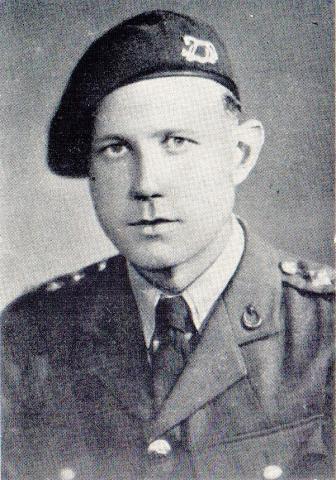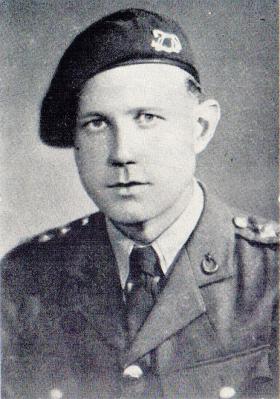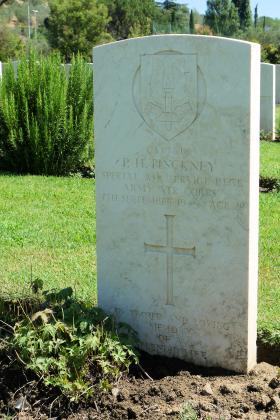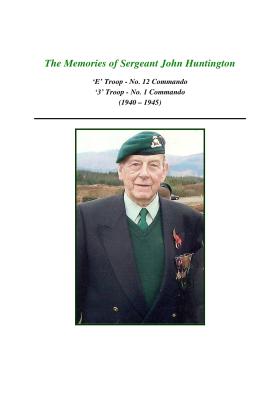Philip Hugh Pinckney was the son of John Robert Hugh and Winifred Pinckney, of Hungerford, Berkshire.
He was educated at Eton College, where he served as a Cadet Sgt in the College’s contingent of the Junior Division Officers’ Training Corps and went up to Trinity College, Cambridge.
Pinckney later enlisted as a gunner into the Territorial Army, with 145 (Berkshire Yeomanry) Field Regiment Royal Artillery, and was granted an emergency commission with the Royal Artillery on 2 September 1939.
He remained with the Berkshire Yeomanry on airfield defence duties until 1940 when he transferred to No 12 Commando, initially as a section commander in E Troop and later, on promotion to Temporary Captain, as E Troop Commander.
Pinckney was held in high regard by the men he commanded; one of them, John Huntington later commented: ‘He was the best officer, man and gentleman, who I have ever met in my life, no matter where I went.’
Jeffrey Quill, the Spitfire test pilot, descibed him as 'a man of rare and timeless character. One might have encountered him accompanying Drake's raid on the Spanish treasure trains in Panama, or steering a fireship amongst the Armada anchored off Calais, or with Shackleton on his epic open-boat journey from Antartica to South Georgia. Equally he was in no way out of place in the Ritz bar; he was a man for all seasons.'*
He commanded a small raid, comprising members of E Troop and naval personnel, on the French coast near Ambleteuse in July 1941, which was thwarted by a German machine gun post and led to two naval members of his party dying from the ensuing fire fight.
Pinckney also took part in Operation Anklet, a diversionary raid on the Norwegian Lofoten Islands, in December 1941.
By the following year he was part of a detachment from No 12 Commando which worked with the Small Scale Raiding Force (SSRF) and in June 1942 was involved in planning a raid (Operation Airthief) to steal a German Focke Wulf FW190 fighter aircraft from a Luftwaffe airfield near the French coast; to be flown back by Jeffrey Quill for evaluation. The plan was abandoned after a Luftwaffe pilot inadvertently landed a FW 190 at RAF Pembrey, Wales, on 23 June 1942, following a dogfight!
Pinckney later took part in Operation Basalt, a raid on the Island of Sark on the night of 3/4 October 1942. One of the purposes of the raid was to capture German prisoners and bring them back to the UK for interrogation and intelligence gathering. With the assistance of an islander, the raiding party was able to locate five Germans sleeping in a hotel annexe, who were promptly taken prisoner by the raiders. However, four of the Germans later tried to escape their captors, resulting in three shot and killed; the fourth managed to escape.
The small scale raids on the Channel Islands caused German disquiet and irritation; in particular the Op Basalt raid, which subsequently prompted a German propaganda communiqué condemning British tactics.
The timing of Hitler’s infamous ‘Commando Order’ on 18 October 1942, ordering the annihilation of all men operating on Commando raids against German troops regardless of circumstances, is too striking to overlook. This order was later to have tragic consequences for Pinckney and others.
The following year he transferred to 2 SAS Regiment, shortly after qualifying as a military parachutist at RAF Ringway and in July 1943 took part in SAS operations in Sicily, in advance of the main Allied landings.
His final deployment in September 1943, on Operation Speedwell, was a parachute mission into Italy behind enemy lines to interrupt German military rail movements across the Apennine passes.
The thirteen men assigned to Op Speedwell were divided into two teams (sticks), one led by Pinckney, and the other team of six led by Captain Patrick Dudgeon MC. Pinckney deployed on this operation while suffering from a back injury and to compound matters his stick was dropped north of Florence into gusty wind, according to another stick member.
Lance-Sergeant Stokes, who was also in his stick, recalled later: “He jumped first and I second. I heard his old familiar bellow and saw him vanish through the aperture and I followed hard on his heels. It was a nice night and I could see everyone clearly - just before we landed I swung out of line and started to drift away and the Captain yelled to me: 'Watch your drift, Stokes, watch your drift.' I hollered back: 'OK, sir.' I then saw him half wave his arm in acknowledgement. That's the last I saw of him as my drift continued, and a few seconds later I landed smack into a house in an Eyetie village. We all got together except for the Captain, and against orders spent an hour and a half looking for him.... There is no doubt at all in my mind that his back gave way when he landed.”
It is believed that he was captured shortly after and shot, in spite of his uniform. Four other members of the Speedwell team were also captured and executed in separate incidents.
Captain Pinckney died on 7 September 1943, aged 28 years, and was initially given a field burial at Baigno. On 22 February 1945 he was reburied in the Commonwealth War Graves Cemetery at Il Girone, Florence.
Further reading:
The SAS in Tuscany 1943-1945 by Brian Lett, published by Pen and Sword books 2011. ISBN 184884446-8
*Spitfire: A Test Pilot’s Story by Jeffrey Quill published by Crecy publishing 1998. ISBN 9780947554729, which dedicates chapter 18 to Operation Airthief.
Compiled by Harvey Grenville with the kind assistance of John Pinckney and John Mewett
Read More




Latest Comments
There are currently no comments for this content.
Add Comment
In order to add comments you must be registered with ParaData.
If you are currently a ParaData member please login.
If you are not currently a ParaData member but wish to get involved please register.